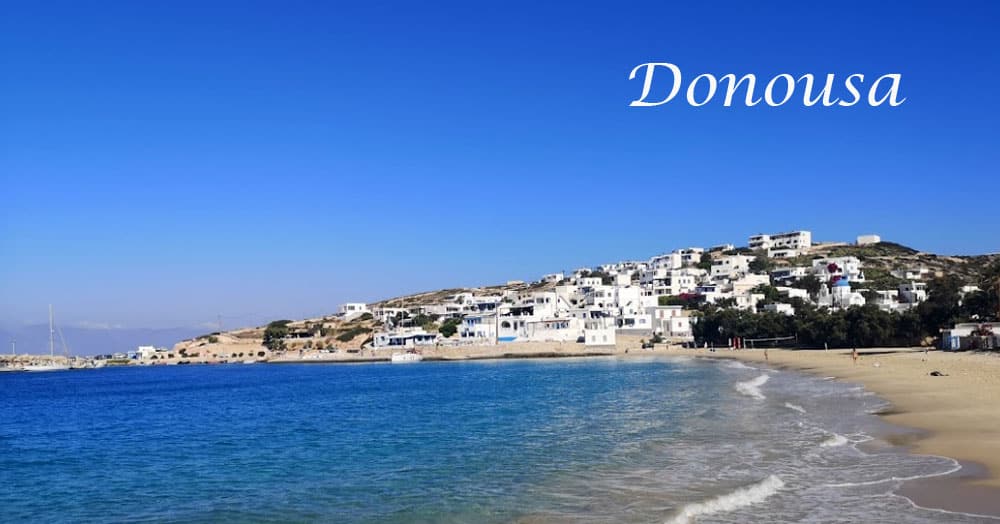Information about the island of Donoussa
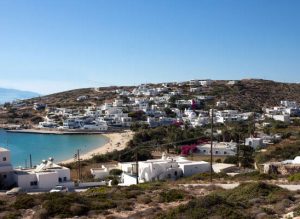
Donousa emits a unique aura that seems to swim alone at the edge of the Cyclades. Maybe that’s why Dionysos chose it to hide Ariadne there, maybe that’s why those who visit it say they’re in love. The island’s natural topography boasts steep cliffs plunging into the sea, while interesting inland hiking trails pass through old farmhouses and rural churches.
The island exudes a peaceful landscape with the jagged coastline in the northeastern part and the wonderful sandy beaches with emerald waters in the southern part. What Donousa lacks in size, it makes up for in color. This island has some of the most beautiful beaches in the Cyclades that will make you want to spend the rest of your trip there.
Donousa is an ideal destination for relaxing holidays next to clear blue waters and breathtaking landscapes. It is the largest of the Small Cyclades and has all the characteristics of a small island with a central settlement where everything is easily accessible and concentrated.
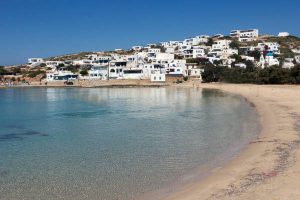
Picturesque villages, idyllic locations, breathtaking coastlines and beaches that offer visual and auditory relaxation, compose a paradise on earth that will enchant you.
Certainly one of the strongest points of Donoussa are its beaches. Some of them are among the most beautiful in Greece with their crystal clear turquoise waters and golden sandy beaches.
Discover and explore the exotic paradises of Skoulonisi, Makares and Melantioi rock islands that surround Donousa. There you will find untouched beaches and fantastic seas for fishing and diving.
Histoy and Mythology
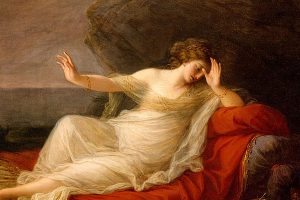
Donoussa’s name has been preserved since ancient times, while the locals also refer to it as Denoussa(3). Travelers and sailors of the 18th – 19th century call it Stenosa or Spinosa, and in the Royal decree for the formation of the municipality of Amorgos it appears as Genousis . Nowadays the island is also known as Denoussa. During the imperial period (27 BC – end of the 3rd century AD), like other islands of the Aegean, it was a place of exile.
Donoussa was used during Roman times as a place of exile. Later it became known in the History of the First World War, because of the German cruiser “Gaiben”, which was refueling at Cape Aspro, thus escaping the English and French warships.
Geography
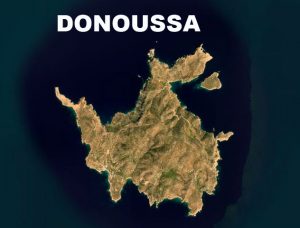
The subsoil of the island is rich in minerals and until 1950 iron, copper, aluminum and iron ore mines operated here. The coasts of the island are sharply divided with many capes, bays and cliffs that end in the sea.
The bay of Xylobatis in the north-west with the impressive “Wall Cave” stands out for its wild beauty, the bay of Roussa in the north is embraced by the deserted rock island Skoulonisi or Skylonisi, the promontory of Moshona is characterized by the high, vertical rocks, while to the south side the sandy beaches alternate with the rocks.
Among the small seasonal streams, the one that flows into Kedros beach stands out, while the presence of a natural spring in Mersini is important. Between Donoussa and Naxos rise the Makares islands, while a few nautical miles to the northeast are the rocky islets of Xtenia.
The blond beaches, vertical cliffs, old terraces, small plateaus, densely vegetated dry currents, underwater caves, small ridges, reefs and dry islands create a rich ecosystem, full of small discoveries for the explorer.
The northwest side of the island is all steep rocks, wildness and wind. To the west, again, a path starts from Stavros and goes towards the rocky beach of Limni and the special landscapes of Plakes and Aspro Kavos. Pure magic from there and the other paths as well.
For those who want to feel the incredible vibrations of this unique rocky island, walk the long path from Stavros to Kalotaritissa, an hour and a half above the wildness of the northern coast.
Follow the detour towards the old mines, which operated until 1940 and produced mainly emery. To see the rusted wagons tumbled down the slope and the tracks run through the mountain to nowhere anymore. And you can go to the top of the Pope, but with the help of the locals. They will ordain you so that the sunrise will find you there.
Τour of the island
Leaving the main settlement for the tour of the island, follow the coastal road that was recently asphalted, leading to the countryside and, more easily, to the small villages of the place. Before leaving Stavros you will see, on your left, the intersection, heading north-west leading to Limni, a Lilliputian and romantic lonely beach.
The path continues to the steep peninsula and the famous for its view of the rocky cape Aspros Kavos, in the area generally called “Xylobati” and whose caves, the locals say, are visited by seals. With access from the sea, there is the great “Wall Cave” with stalactites. Difficult approach, we didn’t see it due to the weather, but don’t miss the opportunity for this important walk.
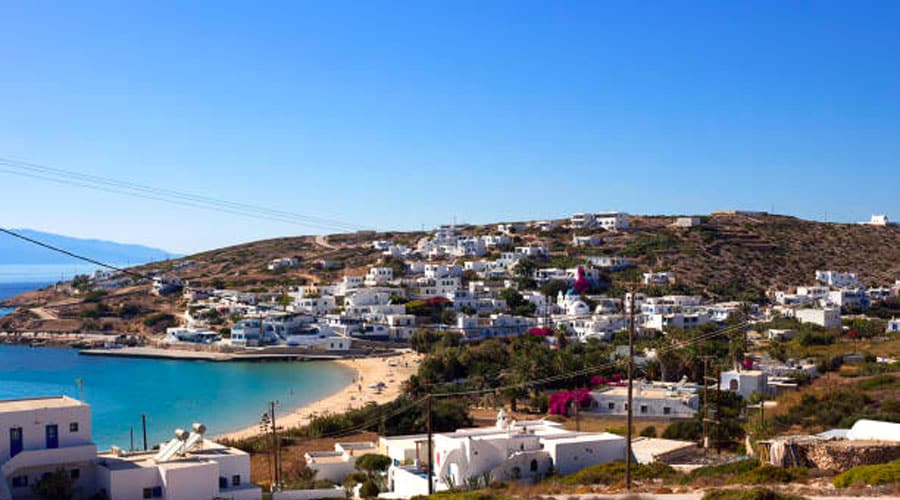
Following the main road there is a second intersection that leads to the foot of Mount Papa (383 m. altitude), with a spectacular view of almost the entire Donoussa and the surrounding islands. On the way back from the Pope it is better to go back by the path that passes the mines (in the past they mined copper, calamine and lulak), and the invisible Trulos (a house). Here in the past years tobacco was planted due to the availability of water from springs that still exist today. They later abandoned the effort due to low production.
From Troulos you will soon come out almost inside the village, (on the road that leads to the twin small church opposite the “Stavros”). All these hiking routes give the true mark of Donoussa, taking in where the cedars and sycamores still take root, the fragrant thrombus, the figs and wild plants.
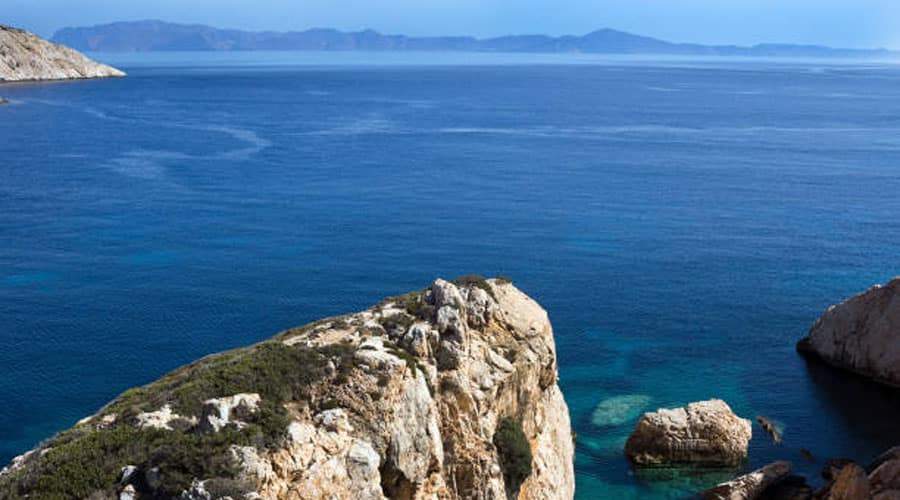
Those who prefer the paved route will not be left complaining since they are given the opportunity to see the wonderful beach of “Kedros” from above and why not go down there for a swim or for a cool ice cream, overlooking the sea. We mentioned at the beginning, that Donoussa, due to its geographical position, was an important and short commercial road, a necessary stop on various trips, commercial or sightseeing, while at times it served as a den and shelter for pirates.
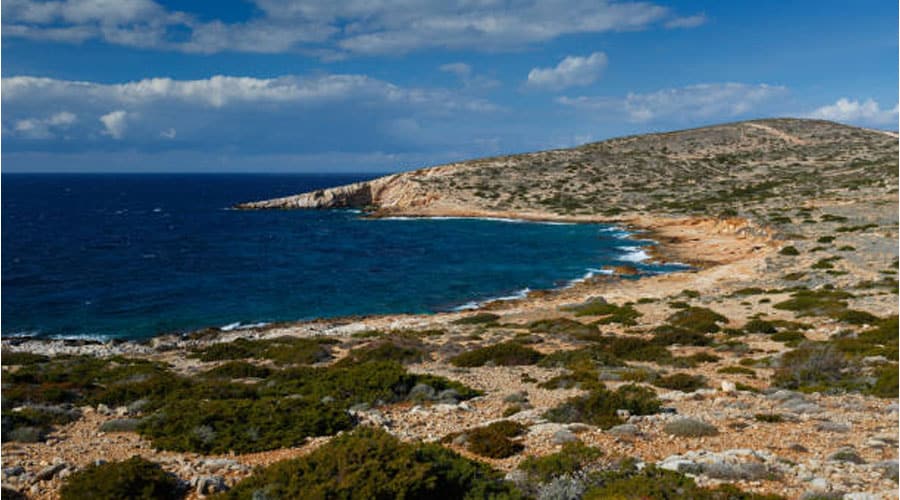
There could be no shortage of incidents from the Second World War, since throughout its duration, the Aegean was crossed from one end to the other by convoys of Italian, German and allied forces. Especially in October 1943, when the German attack against Leros and Samos was imminent, mobility reached its peak, and so did the targets.
On 23/9/1944, at the end of the Second World War, another German ship sank, whose shadow could be seen until recently from the highest points of the island, Vardia peak (386 m. altitude) and Mount Papa (383 m. high). The ship was at the bottom of the beach of Kedros, until 2000 when it was cut up and withdrawn, leaving only the keel of the boat.
At 4.7 km from the port, almost on the ring road and to the left, Haravgi appears. A small stone-built settlement, the second one encountered by the visitor heading towards Kalotaritissa. The authentic traditional houses have come out of the depths of centuries, knowledge and human wisdom in construction are surprising.
The dirt road stops at the small threshing floor, but continues on a path that takes the researcher higher up to the “Pano Mahala”, with its impressive dry stones and houses, some with clean stone and others whitewashed, with carefully painted shutters, shutters and front doors with the dark blue, the color of the sea. They impress with their austerity, with the functional and today stone-built ovens in the courtyards, highlighting with rare clarity what life, contact with nature and pleasures were really like, many, many years ago.
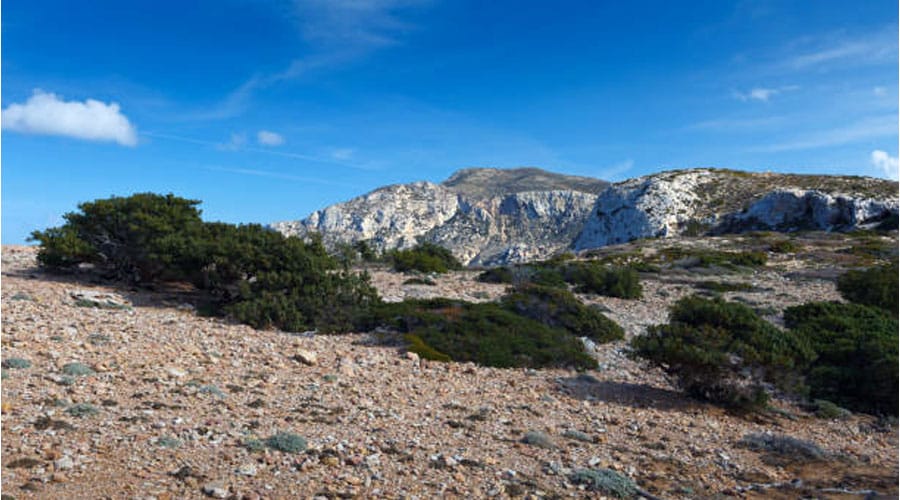
The electricity came here in 2002 and until then there were no electrical appliances, with what this means for the aesthetic tradition of the houses and, above all, their interiors which are equally simple, with built-in beds and built-in cupboards, while part of , is used as a warehouse for the necessary things, including the lime for the refined whitewashes, outside and inside the house.
From Kato Mahalas you can clearly see the opposite slope with the terraces of crops that start from low, climb up and stop at the half-demolished and obviously abandoned block of stone buildings.
Mersini, just 1.5 km from Haravgi, is the first entrance to the village. If you go right in 700 meters you are at the church of Agia Sophia, while a little before, on your left, is the cement road that ends in a dirt road to the large plane trees and the Mersini spring with drinking water.
A very beautiful place with a green natural environment that for a while deceives the heat that suffocates the place. With absolute justification, the residents hold the festival of Agia Sophia in this location on September 17, just three days from the big one, the Holy Cross.
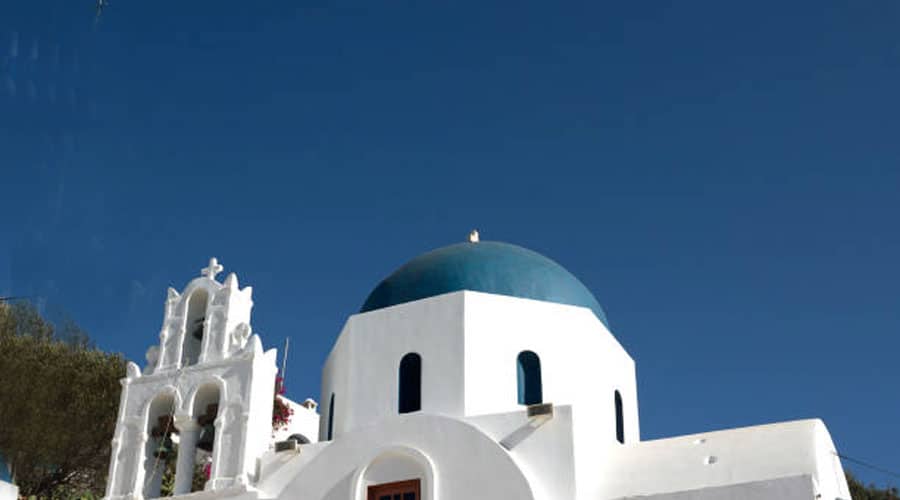
The stop is more than necessary while the presence of the cool spring works like a magnet for birds, animals, but also people who come from the village and nearby Haravgi with their donkeys to get water. The now narrow path continues to descend, and in 30′ it reaches the wonderful beach “Livadi”.
From the church of Agia Sophia, but also before the dst. for the village, a small part of the old cobbled road that connected the village to the capital Stavros is preserved. The church, as the carved inscription on the lintel of the entrance informs us, was built in 1948, while next to it in the uncovered area, there is a built white stone structure with a cross and nave like a small church. It is probably an ossuary, as you are used to on some islands of the Cyclades.
What to do and see in Donoussa
The Cave of wall
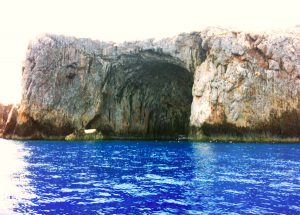
It is famous for its beautiful atmosphere and crystal clear waters. Access to the cave is by boat from the port of Stavros.
At the cave of Tihos, accessible from the village of Stavros, you will admire the remains of the settlements of the Geometric period and of course, entering the cave by boat, you will see the small stalactites that decorate it. Clear blue waters
The Mersini Spring
Following the path to Livadi beach, a pleasant surprise awaits you halfway! At the roots of a century-old plane tree, a spring with clean drinking water will cool you down and give you a break from the heat. You can also take a walk to the beautiful traditional village of Mersini, located above the spring. is a source of drinking water located on the north-eastern side of the island. The surrounding area has become verdant due to the abundant running waters.
The church of Panagitsa
Panagitsa, the small church on top of the hill in the village of Stavros. Your goddess is breathtaking. The sunsets are simply wonderful. So if you are a couple or just romantic, if you are crazy about photography or you just want to enjoy the Aegean from above this is one of your best opportunities.
The Seal Cave
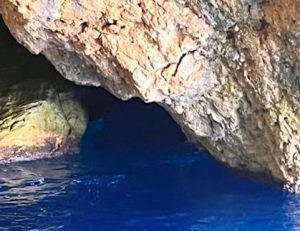
Its name is due to the fact that the cave is inhabited by seals, but the locals claim that the area has been inhabited by the rare mammals for many years.
The seal cave is a geological crack in the rocks, 40 meters wide and over 10 meters high. Its size is such that in the past it was used as a pirate shelter. In the rocks of the cave one discovers dozens of species of sponges, corals, bryozoans, hydrozoans and rhododendrons.
The Shipwreck of the destroyer Orion
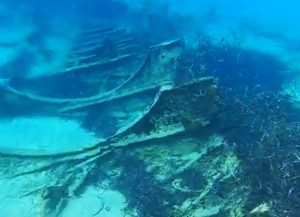
Since 1936, the ship Orion had joined the force of auxiliary ships of the Hellenic Royal Navy and had been assigned the role of the ship of light houses missions.
To this day, at the bottom of the bay and at a depth of 5-6 meters, there are still the wreckage from the ship’s boat which, when the weather is good, is visible
But you will really get to know Donousa through its paths and by going around its coasts. The tourist infrastructure that has been developing in recent years currently covers the needs of the island, while it has not altered its authenticity in the slightest.
The windmils of Donousa
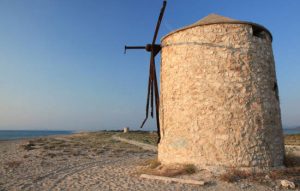
The Windmills of Donoussa are one of the most beautiful spots of the island and are located on the plain of Messaria. In the past, windmills were powered by the wind, as the Cyclades are famous for their stormy winds.
Although the windmills are no longer in operation, they continue to be a symbol of the island’s long history. Here one can admire the panoramic view of the endless blue of the Aegean.
Chapels and Churches
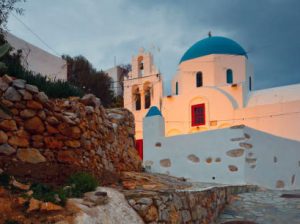
The church celebrates on the 14th of September, so if you plan your holiday around that time, you will find yourself in a climate of sweltering and brilliant island celebrations.
The Twin Churches of Panagia and Agios Ioannis are the most beautiful churches of Donoussa located on the slope of a hill in the eastern area of the island’s capital. Both are examples of traditional Cycladic architecture.
The chapel of Agia Sophia is one of the most charming chapels of Donoussa located in the village of Mersini and celebrates on September 17. Here one can admire the panoramic view of the Aegean Sea.
The ruins in Vathi Limenari
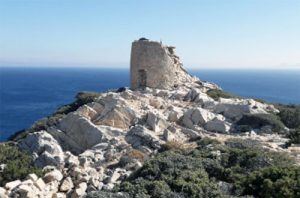
The interesting fact about the ancient settlement of Donoussa is that it is one of the few Cycladic settlements of this period that is fortified. Archaeologists estimate that a large part of the settlement on the south side sank into the sea. The rich collection of ceramics found in the settlement includes large vessels for storing and transporting liquids, smaller table vessels, cooking utensils, etc., and is kept in the Archaeological Museum of Naxos
Visit the islets around Donoussa
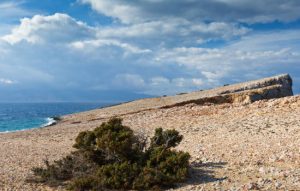
To the west are Makares, three rocky islands. In one of them, Agios Nikolaos or Megalo nisi, the inhabitants of Donoussa in earlier times cultivated grain. The second islet called Prasini or Agia Paraskevi is separated from Agios Nikolaos by a narrow strip of sea with a depth of only 1.5 meters. The sea at this point is blue-green and very beautiful, but the depth allows for crossing only by small boats, with low speed and special care. The third island is called Strogyli, or Strogylos. Finally, to the north-east of Donoussa are the islets Melantioi or Htenia or Vouves.
Sports and activities
The beach of Stavros with its wonderful sandy beach is ideal for athletes and fans of beach volleyball. Put on your sunscreen and splash out on the beautiful beach for a crazy spree with your fellow athletes!
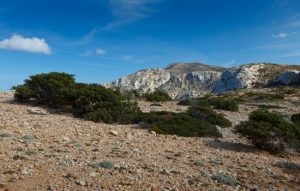
The path leads to the beautiful bay of Kalotairitissa. Another interesting path includes the one that leads to the chapel of Panagitsa on the hill of the Cross.
It is also worth following the route that starts from the beach of Pera Panda and goes up the hill behind the village of Stavros. There you will enjoy a panoramic view of the neighboring islands of Amorgos, Heraklia and Koufonisia.
Grab your mask and dive into Kedros Bay! It is definitely an amazing experience as you will have the opportunity to discover the wreck of the German battleship Orion which was sunk by the Allied Forces during World War II.
Local festivals
Every July 27th, the Festival of Inns takes place in Donoussa, which hosts a series of folk art and photography exhibitions.
Every August 15, the established celebration in honor of the Dormition of the Virgin takes place in Donoussa, hosting a series of folklore events with live traditional music and dances.
Every August there is also a Treasure Hunt, a game based on folktales about pirates using the island as a base.
Every September 14, the traditional celebration in honor of the Cross takes place in the Chapel of the Holy Cross with traditional music, dance and local delicacies.
Every September 17, the traditional feast in honor of Agia Sophia takes place in the Holy Church of Agia Sophia in the village of Mersini.
Villages of Donoussa
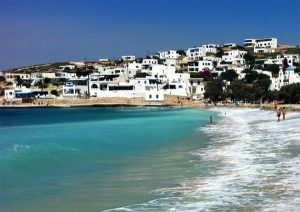
The largest village of the island, its capital and port, is Stavros or Kampos. There you will find one of the most beautiful beaches of Donoussa and everything you need for your stay. Rooms for rent, taverns, ouzo, bar and grocery store.
It is worth visiting the Church of the Cross and learning its history. On September 14, on the Feast of the Cross, you will have the opportunity to watch the liturgy, the event in the forecourt and to dance “ball” at the great festival organized in the taverns of the village with traditional bands.
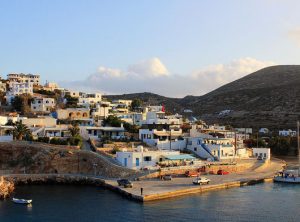
The sandy beaches with crystal clear waters in Stavros, Kedros, Livadi, Phykio and Kalotaritissa await you for swimming and relaxation. Don’t miss to visit the two caves of special beauty that exist on the island with unique access from the sea. One is the cave of the Wall with stalactites in the area of Aspro Kavos and the other is the Seal Cave, in Kavos of Moschonas, which as its name testifies is a seal sanctuary. A boat runs to the caves, but also to the beaches of the island.
Stavros the capital of Donoussa
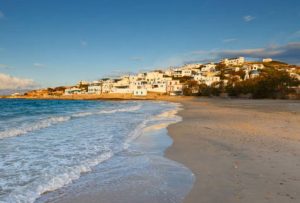
The icon of the Holy Cross was found after days in Amorgos from where it was collected to be rebuilt at a higher point but this time so that it would be more protected. It celebrates on the 14th of September, when there is a litany and a great festival.
High on the hill above the harbor is the white chapel of Panagitsa. An inscription above its entrance reads the year 1892. From there you will enjoy a panoramic view of the entire settlement that spreads out at your feet, as well as the sea. Ideally, make sure to be at this spot when the sun is setting.
All the life of the island emanates from the capital, which has all the shops, cafes, taverns, mini-markets and rooms for rent, capable of serving a fairly large number of visitors. The few minutes that the boat catches are enough to disrupt the port and the lives of the locals.
New goods arrive, mail, new visitors, most of them foreigners, but without missing the Greeks. When the ship leaves, the voices, the whistles, the marching of the cars and trucks subside, and that unique quietness comes, you immediately realize that you have arrived in one of the authentic Cyclades.
The village is smaller than what we are used to seeing, the wild and furious development seems not to have reached here. A first taste of hospitality and information about the island and its attractions, is a coffee stop at the elevated cafe – mini market – restaurant (in summer), in front of the pier.
Nice view towards the beach of Stavros, the smallest harbor protected by a breakwater where the locals moor their boats and fishing boats, while higher and to the east, on top of the hill, you can see the all-white double church of Panagia and Ag. Ioannis. Depending on the time, in addition to the special coffee, you will taste Mrs. Evangelia’s homemade snacks and even more delicious food. The walk between the houses of the coastal settlement is one of those that must be done in order to see and breathe this very different air of Donoussa
Messaria
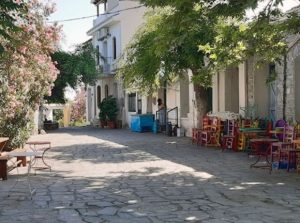
Near Messaria you will find a small but very beautiful beach with pebbles as well as an old windmill out of a total of two that used to exist on the island.
Mesaria is one of the off-the-beaten-path destination that offers an authentic taste of the island. This small village promises a unique and unforgettable experience that will leave you with cherished memories and a renewed appreciation for the timeless beauty of the cyclades islands.
Mersini
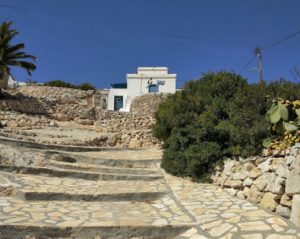
Due to the waters in Mersini there are many fruit trees, plane trees and vegetable gardens. At the top of the hill that exists in Mersini you will find the church of Agia Sophia and nearby Livadi beach.
Mersini has not undergone any alteration. In the small settlement, you will find the church of Ag. Georgiou built in 1984 at the expense of the Prasinos family, as the newer, marble inscription informs us. A typical traditional village, without any differentiation in architecture from Stavros and Mesaria.
Its stone-built houses are interesting examples of folk traditional architecture. The area is full of sources of drinking water, which helps with agricultural work and the existence of fruit trees.
The houses are stone-built, while there are few taverns in the settlement. At the top of the hill, the church of Agia Sophia has been built with the homonymous festival on September 17.
Livadi and Phykio beaches are located nearby to the south. North-east of Mersini is Fokospilia, a small cave with blue-green waters, where seals used to shelter in the past.
In the village there are also two taverns, “Tzi Tzi” with nice mezes and a breathtaking view, and the tavern “I Kori tou Michalis” with fantastic cuisine.
Kalotaritissa
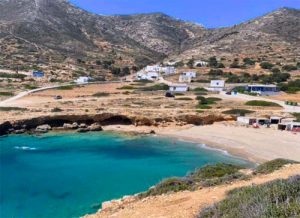
There is only one tavern in the village, but it has excellent food, with burgers, braised goat and wine rooster being the best.
Probably its name comes from the word kalotaria, which means clear weather .
Whenever it’s windy, the solution is Kalotaritissa bay with its three beaches, Sapunochoma with coarse pebbles, Mesa Ammos with fine and sandy Trypiti.
Beaches
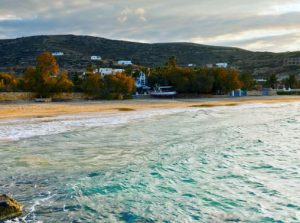
Even more deserted and untouched are the beaches on the nearby rocky islands of Skoulonisi, Makares and Melantioi, also ideal for fishing and diving, where you will arrive by private boat or chartered boat.
For many Livadi is the most beautiful beach of Donoussa, as it has wonderful deep green waters and white sand. It is located in a sheltered bay below the settlement of Mersini. There are tamarind trees for natural shade, while on the left side of the beach the picturesque “wires”, places where residents keep their boats in the winter, are fascinating.
Local cuisine
The traditional food of the island is patatato, which is essentially braised meat with potatoes. Other local delicacies are octopus in Thrace, crab, pastourmas and buttered thrapsalo. Among drinks, well-known are red semi-sweet or sweet wine which are local products, such as Budomato or Rosaki.
The delicious cuisine of the island includes goat stuffed with rice, pork crab, fried herb pies with chard and fennel and, of course, the wonderful “axialomizithra” and the homemade pasta “klotas macaroni” and “pitaridia”.
The local red semi-sweet or sweet wine from varieties such as Budomato, Rosaki, Mandilaria, Athiri or Fokiano is very delicious, while in October the residents “bake” raki, which is served with dried figs. The “sweet cuisine” of Donoussa is complemented by the traditional pasteli (served in lemon leaves), and the wonderful fotopites, loukumades and xerotigana that they make during the Festival of Theophany in January.
Where to eat
Captain George
Captain George is a pure fish tavern where you will enjoy fresh fish and seafood delicacies. It is located in Stavros and has a wonderful view of the port.
The daughter of Michalis
The tavern “The daughter of Michalis” is located in the village of Mersini and is famous for its exceptionally well-cooked dishes and large hearty portions. It is considered the top choice for Donoussa.
Mitsos Tavern
Beautiful traditional tavern in the settlement of Kalotaritissa. It offers dishes with authentic flavors that use local products as raw materials. Remember to order the famous burgers which are amazing!
How to get to Donoussa
By Air
Begin by flying into Athens International Airport (Eleftherios Venizelos). This is the main international gateway to Greece.
Alternatively, you can fly to some other nearby islands with airports, such as Naxos or Mykonos, and then take a ferry to Donoussa.
By Ferry
Blue Star departs from Piraeus for Donoussa every Monday, Wednesday, Thursday and Saturday at 17.30. The journey takes about 7 hours, except on Thursdays when it takes an hour longer. “Skopelitis” also arrives in Donoussa every Monday, Wednesday, Saturday. It departs from Naxos at 14.00 and reaches the island at 18.00
The ferry journey from Piraeus to Donoussa can take several hours, so be prepared for a long trip.
Ferry from Naxos to Donoussa: The ferry Skopelitis connects Naxos with Donoussa daily
